Greetings,
I’ve been lurking around here for sometime, so i thought I would contribute. Did a search to see if anybody built there own wall jacks. Found a lot of people using the Proctors and a few of you using the qual-craft. I wish I had the money for the Proctors or Tranzporters but I don’t, so I built my own. I was sitting on the can (where I do all my great thinking) and was looking at the PDF parts diagram for the Tranzporter’s and thought the same principle could be done with 2×4’s and crank style winches. This is how I did it.
What you need. 2, 12′ 2×4’s, 1/2″ osb or plywood spacer, 3″ wire sheath or pulley, strap hinge, and crank style winch with cable.
Nail your 2×4’s together with your 1/2″ plywood spacer in the middle ( sort of like a header) the plywood spacer roughly needs to be the same thickness as the wire sheath/ pulley at the top. Install the wire sheath at the top in between the 2×4’s with a big bolt. I must stress that this part doesn’t have to turn like a pulley. The cable just needs something smooth to glide over. A sheath works great. Mount a strap hinge on the bottom. Install the crank on the pole and run the cable over the sheath at the top. I put an L bracket on the end of the cable for hooking under the top plate. Here are a few pics.
Vester
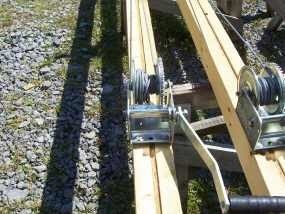
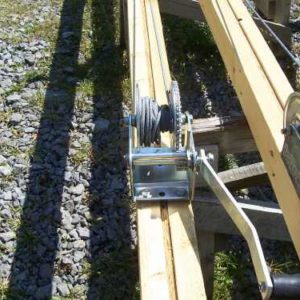
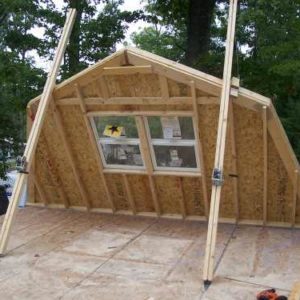
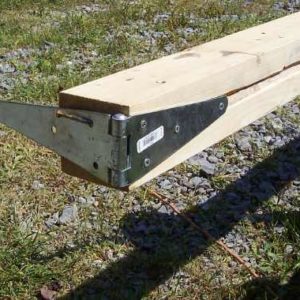
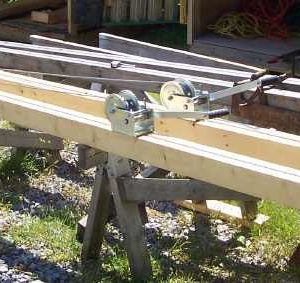
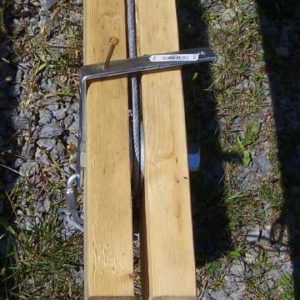



















Replies
Hey shed! I actually "invented" wall jacks back when I built my first house by myself. Of course I then discovered that Proctor had already been marketing them for many years , thus dashing my hopes of patents and millions of $$$ in residuals...ha ha
Funny thing is, mine were almost identical to yours. I used double 2x4s, boat winches with 1/4" steel cables, and hinges. I think the whole mess cost me less than $75 for the pair. They've stood up many walls for me in the ensuing years.
Hey- you stole my invention! Only I used UniStrut instead of 2x4s because I had it at hand and had a use for it when I was done.
Nice job!
What size boat winch did you use?
I made a rig to lift and float my boat lift and ruined a winch that was too light for the job. (They seem to be rated for pulling rather thatn lifting.) Ended up using cheapo come-a-longs, but would like to replace with the winches.
Come-alongs would work slower and lift more weight than the winches. But they'd have the advantage that you can use them for a lot of other purposes.
-- J.S.
Agreed. I'd prefer the winches in both uses - your jacks and my lift.
Do you have any idea what the lift capacity is on your winches? They come in several sizes.
Actually, I have the come-alongs, not winches. They come in 1 and 2 ton versions, Maasdam is the make.
-- J.S.
Oops, sorry! I'm hard-of-reading sometimes. It's shed builder who has the winches. I'll try to pay attention.
If you use the come-a-longs for wall jacks, will the drums hold enough cable for lifting walls or is there some intermediate step involved?
I do have a Maasdam come-a-long that uses a 1/2" rope and feeds it through so any length rope can be used. Do you think that would be safe to use on a wall jack?
thanks for your replies,
oldfred
The cable type come-alongs I have are of limited "throw"- they don't spool enough wire rope to do the job of lifting a wall. Plus they're a PITA to spool out cable to use the things in the first place. Proper chain-type come-alongs are still too spendy, but it's only a matter of time 'till the Chinese are mass producing these like the cheap chainfall hoists. You can now get a chainfall for about 1/4 the price you could about ten years ago.
If you use a couple jacks, the worries about a single cable failure are reduced somewhat. And unlike when you're pushing a wall up manually, you're never underneath the lift. In the unlikely event that it does come down on you, it doesn't come down on "you". That's worth something to me!
I hinged mine on the winch side of my "post" rather than the back side as you've shown in your pics. Worked better with the UniStrut I was using, plus it gives you good access to screw the strap hinge into the joist.
UniStrut!! Now we're talking. Never thought of that. It's probably a little bit lighter than the nailed together 2x4's.
The winches that I used are rated at 1400lbs each. I tested them on the short gambrel wall (16'wx 9't) in the picture. It was fully sheathed with overhangs and facia on. But it lifted it like nothing. The only problem with the winches is, of course, the handle will eventually hit the top plate. I just left my handle loose and kept winching it in half turns. A little bit tedious, but it works, then once the top plate clears the handle it's smooth sailing from there.
My dad suggested that I can remedy that problem with some socket wrenches and sockets that fit the bolts of the crank.
The best thing I loved about this setup was the price. $130.00 for everything. Could be a lot cheaper if I ordered the winches but I was in a hurry to try it out so I bought mine at the local Tractor Supply. They were $40.00 a piece. Northern tool has the same winch for around $15-$20.
Vester
Edited 9/25/2006 4:33 pm ET by shed builder
Anybody use hinged vertical 8 ft 4x4, cable from wall to top of 4x4 to truck or tractor on the ground?
Looks like a good subject for an FHB article.
"It's always better to have regrets for things you've done than for things you wish you had done..........."
How do you plumb and level your windows if you install them while the wall is flat. Or are they just tacked in there and plumbed up later.
How do you plumb and level your windows if you install them while the wall is flat. Or are they just tacked in there and plumbed up later
Windows are installed parallel to the top plate, then squared up by measuring the diagonals. If your deck is level, the window will be level. If your windows are square, and the top is level, the sides will be plumb.
blue
Alot of ifs.
Alot of ifs.
Not really. The main criteria for windows to function properly is that they be hung square. They could be out of level by 1/2" and they still will function perfectly if they are square.
That said, I've can say that I've hung thousands of windows using the method that I described and I cannot remember one window that wasn't level. It's simple facts: the decks are level, the top plate is parallel, and we set the tops of the window paralell to the top plate. How could the window be anything but level?
Please note that we never frame on unlevel slabs as many in here do. All our frames are on poured walls or block and if the decks aren't level , we level them with shims. If I had to work off wavy slabs, I'd either figure a way to create a perfectly level top plate, or I'd retire.
blue